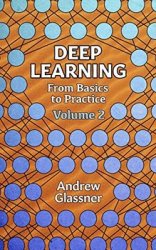 Название: Deep Learning, Vol. 2: From Basics to Practice
Название: Deep Learning, Vol. 2: From Basics to Practice Автор: Andrew Glassner
Издательство: Amazon Digital Services LLC
ASIN: B079Y1M81K
Год: 2018
Страниц: 914
Язык: английский
Формат: True PDF
Размер: 143.6 MB
You don't need any previous experience with machine learning or deep learning for this book. You don't need to be a mathematician, because there's nothing in the book harder than the occasional multiplication. You don't need to choose a particular programming language, or library, or piece of hardware, because our approach is largely independent of those things. Our focus is on the principles and techniques that are applicable to any language, library, and hardware.
Even so, practical programming is important. To stay focused, we gather our programming discussions into 3 chapters that show how to use two important and free Python libraries. Both chapters come with extensive Jupyter notebooks that contain all the code. Other chapters also offer notebooks for for every Python-generated figure.
Our goal is to give you all the basics you need to understand deep learning, and then show how to use those ideas to construct your own systems. Everything is covered from the ground up, culminating in working systems illustrated with running code.
The book is organized into two volumes. Volume 1 covers the basic ideas that support the field, and which form the core understanding for using these methods well. Volume 2 puts these principles into practice.
Deep learning is fast becoming part of the intellectual toolkit used by scientists, artists, executives, doctors, musicians, and anyone else who wants to discover the information hiding in their data, paintings, business reports, test results, musical scores, and more.
This friendly, informal book puts those tools into your pocket.
Table of Contents:
20 Deep Learning
21 Convolutional Neural Nets (CNNs)
22 Recurrent Nerual Nets (RNNs)
23 Keras Part 1
24 Keras Part 2
25 Autoencoders
26 Reinforcement Learning
27 Generative Adversarial Networks (GANs)
28 Creative Applications
29 Datasets
30 Glossary
Скачать Deep Learning, Vol. 2: From Basics to Practice